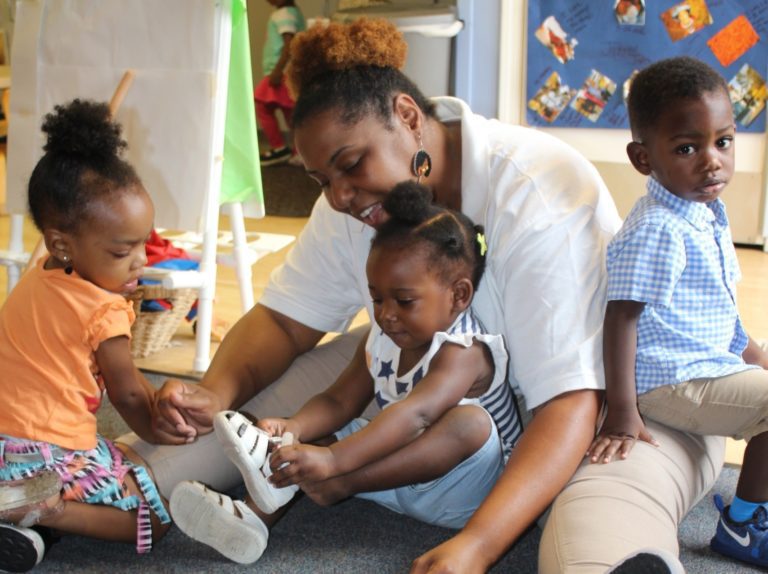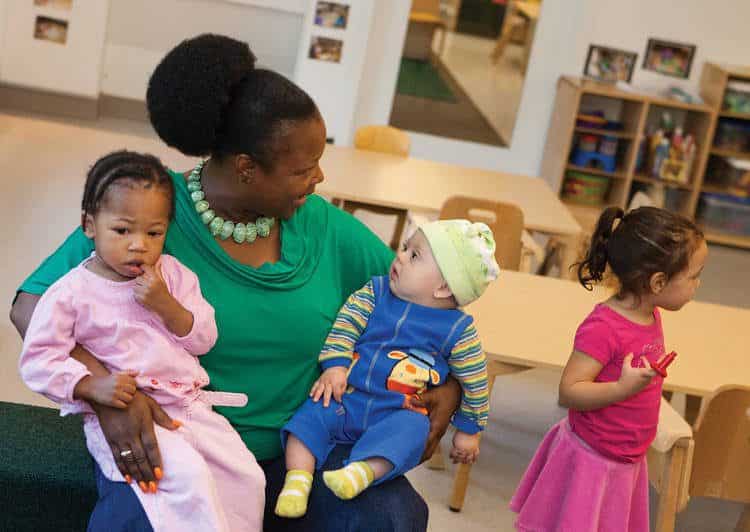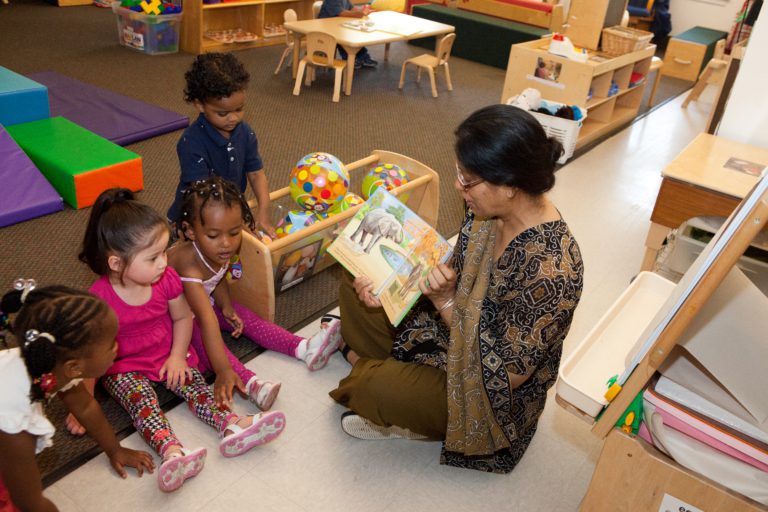How to Care for Infants and Toddlers in Groups

J. Ronald Lally, EdD, was one of the pioneers in the field of infant/toddler development. Dr. Lally was a Founding Member of ZERO TO THREE.Contributions to the…
There are six key components of early group care experiences.
How the components of group care are addressed determines, to a large extent, the opportunities for responsive caregiving and caring relationships in infant/toddler child care.
Out-of-home child care for infants and toddlers, if done well, can enrich children’s early experiences. It can also be a therapeutic component of services to at-risk children, providing a safe and consistent base for protection, prevention, and treatment.
Unfortunately, although more and more children in this country are moving into group care at younger ages and for longer periods of time, we are missing opportunities to provide quality care. Indeed, current practices in many infant/ toddler child care settings actually hinder caregivers, children, and parents from forming and sustaining the deep, responsive, and respectful relationships that are the hallmark of quality.
The process of forming a strong positive identity should occur in a setting that offers security, protection, and intimacy. It doesn’t happen in “school”; it happens in a continuing relationship with a caregiver.
In the day-to-day give and take of good infant/ toddler child care, children and their caregivers relate in a way that looks much like a dance, with the child leading, the caregiver picking up the rhythm and following. When a caregiver reads and responds to the young child’s messages with sensitivity, the child’s hunger to be understood is satisfied. The conviction that “I am someone who is paid attention to” becomes part of the infant or toddler’s identity.
In order to create and sustain intimacy in group child care, we must address six key components of early group experience: group size; quality of the physical environment; primary caregiving assignments; continuity of care; cultural and familial continuity; and meeting the needs of the individual within the group context.



Group Size
We create chaos and confusion when we put too many infants or toddlers in one group, even with an appropriate number of adult caregivers. As the number of infants in a group goes up, so do noise level, stimulation, and general confusion. The group’s intimacy is gone. Children look lost and wander aimlessly, not quite knowing what to do. When there are too many children, shared experiences and discovery through play are inhibited. Smaller groups mean fewer distractions and children’s activities that are more focused. In small groups, very young children are able to make connections, form caring relationships, and learn to understand other children.
For children not yet mobile, ZERO TO THREE (1992) recommends that group sizes should be no larger than six; the caregiver/infant ratio should be no more than 1:3. Children crawling and up to 18 months, the group size should be no more than nine, ratios no more than 1:3 (explorers are active and need a watchful eye). Children 18 months to three years should have a group size of no more than 12, ratios, 1:4. Centers, group homes, and family day care homes with mixed age groupings should never have more than two children under two years of age in a single group.
Infants and toddlers with disabilities who do not require special medical support can easily be included in environments with this suggested ratio and group size. Children with disabilities are children first; the care they need is often exactly the same as the care typically developing children need.
Group Care Environment
The physical environment—indoors and out—can promote or impede intimate, satisfying relationships. Carollee Howes discovered that in family day care homes in which dangerous objects and fragile prized possessions had been removed from the area in which infants and toddlers played, caregivers smiled more, encouraged exploration, and gave fewer negative comments (“Don’t touch that!”) to infants and toddlers. In an infant/toddler center, a hammock invites a caregiver to cuddle one or two babies.
The environment affects caregiver/parent relationships. A comfortable place for adults within the children’s environment can encourage parents to visit throughout the day and can also be used to encourage continued breastfeeding with infants. A place for parents to sit comfortably for a moment at the end of the day acknowledges the parent’s needs and encourages conversation.
When dangerous objects and fragile prized possessions were removed from the area in which infants and toddlers played, caregivers smiled more, encouraged exploration, and gave fewer negative comments to infants and toddlers.
The environment affects relationships between children as well. Considering the amount and arrangement of space and the choice and abundance of play materials can either increase the chances that young children will interact positively with each other or increase the likelihood of biting, toy pulling, and dazed wandering.
A caregiving environment can encourage or impede flexible, individualized care in a group setting. With easy access to the outdoors, the daily rhythms of infants and toddlers can be accommodated. In too many centers, however, infant/toddler time on the playground is rigidly scheduled and subordinated to the schedules of groups of older children. Infants and toddlers need small amounts of food and drink throughout the day to support their emotional, social, and physical well-being. A child who is thirsty or hungry cannot interact successfully with other children or adults. A small refrigerator and modest equipment for warming food will allow caregivers to feed infants on demand and offer snacks to toddlers frequently. But too often in child care settings, feeding routines accommodate the kitchen rather than the child.
Primary Caregiving Assignments
The assignment of a primary caregiver to every child in group care means that when a child moves into care, the child’s parents know, the director of the program knows, and the caregiver knows who the person is who is principally responsible for that child. Primary caregiving does not mean that one person cares for an infant or toddler exclusively, all of the time—there has to be teaming. Rather, primary caregiving implies the infant or toddler has someone special with whom to build an intimate relationship. Primary caregiving assignments are an excellent example of program policy that takes the encouragement of relationships seriously.
Two vignettes adapted from ZERO TO THREE ’s Heart Start: The Emotional Foundations of School Readiness (1992), illustrate the difference a special relationship can make to a young child’s experience in child care.
The way it shouldn't be.
Tim stood just inside the entrance to the playroom. He was sturdy for one-and-a-half, but short. The noise was jarring, and he looked around for the woman his mother talked to when they came in. She had said to his mother, “He’ll be fine—I’ll get him started,” and she had taken his hand. But now, just as fast, she was gone. It scared him as much as the other time. This was not a good place to be. He wanted his mother and he wanted to go home. A boy bumped him hard, and Tim fell. He crawled over to that woman. He sat down and fingered some colored blocks on the floor. A big boy came and grabbed one and stepped on his hand. Tim yelped and cried and looked around. He held his hurt hand in the other and the tears ran down his cheeks. No one saw.
Two weeks later: Tim stood just inside the entrance to the playroom. It was very noisy. A boy ran past him and bumped him. Tim lunged for him and pushed him down. The boy cried, and Tim walked over to the blocks. He picked some up, and a bigger boy came and grabbed them. Tim gave them up quickly and then turned and saw a smaller boy who had some. He pulled them away from him. The boy cried. Tim looked at the blocks. He couldn’t remember what he’d been going to do with them, so he threw them down. They made a very satisfying sound. He picked up several other toys nearby and threw them. Suddenly one of the women was there yelling at him and holding his arm very hard. She was saying lots of things to him, and now she said, “time out,” and scrunched him on a stool. He tried to get up but she wouldn’t let him. She waved a finger in his face. He thought about biting it. She went away. He didn’t like this place. He wanted his mother. He wanted to go home.
What Tim is learning in this child “care” center is almost everything we would not want him to. He is important to no one here and must fend for himself, as must others. For some it’s like home—for others it’s newly terrible. For all, it is a potentially damaging experience.
The way it should be.
Tim and his mother had visited the center twice in the last week. They had spent time with Mindy, who told them she would be Tim’s primary caregiver. Both Tim and his mother felt comfortable with Mindy. She was interested in them, wanted to talk regularly about Tim’s progress, and seemed to understand how Tim’s mother felt about leaving Tim to go to work.
When it was time for her to go, Tim’s mother reminded him she was leaving today. He looked surprised and climbed off the horse. Mindy picked him up and said, “Let’s go to the door and say good-bye to your mother.” Tim wanted to go with his mother. But his mother really seemed to be going to leave him, so he clung closer to Mindy, who cuddled him and talked quietly. Then his mother was gone. It was like everyone in the world was holding their breath at the same time, but Mindy held him and patted him and talked quietly, and then everyone began to breathe again. Tim could see the toys and children, but mostly he liked hearing Mindy’s voice. Ten minutes later, ‘Tim was on his horse. He wasn’t as wholly confident as 20 minutes before, but he could still ride, and Mindy was close by and always noticed when he looked at her.
Two weeks later: After his mother kissed him, Tim waved good-bye and then he said, “Hi” again to Mindy, who ruffled his hair. Tim made a beeline for the block area, but when he got there Wong Chen had corralled all of the red blocks Tim wanted. Tim squatted down and watched Wong Chen. In a minute, Mindy came over and squatted down too, and they both watched him. Then Mindy said, “Tim likes those blocks too, Wong Chen; would you let him play?”
…Later, Tim started to build a big car with red blocks, a car like his mother’s red car. His mother was working. She would come later. “Mommy later,” Tim said. Mindy heard him. “She will, Tim,” said Mindy. “She’ll come after your nap.“ “After nap,” said Tim, and then he said, “See my car?”
Tim is learning a lot in this center, mostly very good things. He feels important. He feels heard and understood. He feels protected, and his primary caregiver helps him negotiate the difficult things with other children. He is learning to cooperate and to pay attention to what other children need and want. There is enough space, there are enough providers, just enough children, and abundant affection for everyone.
Continuity of Care
Having one caregiver over an extended period of time rather than switching every 6 to 9 months or so is important to the expansion of a child’s development. Switching from one caregiver to another takes its toll. The child has to build trust all over again. When a very young child loses a caregiver, he really loses part of his sense of himself and the way the world operates: The things that the child knows how to do, and the ways that he knows to be simply don’t work any more. Too many changes in caregivers can lead to a child’s reluctance to form new relationships.
Continuity of care—or the lack of it—in a child care program has important implications for the group experience. A child with a new caregiver has to work hard to get her messages across. The caregiver can only guess at what she wants. There is confusion and stress for both child and caregiver. If a child deals with change by acting out his frustration, this will have an impact on the entire group. With a caregiver who knows him, however, a child can express need less dramatically. The better somebody knows a child, the more subtle the cues are that will inform that person of what it is that the child needs.
Too many changes in caregivers can lead to a child’s reluctance to form new relationships.
Continuity of care is important for caregivers and parents as well as for children. When infants and toddlers are moved to a new room as they reach a new developmental stage, caregivers don’t get to see the fruition of their work. Parents often experience tremendous grief when they first place their infants in child care. Trust in the caregiver builds slowly, as they realize that the caregiver is attached to their child, loves their child, and supports the special parent-child bond. With a change in caregivers, not only the child, but parents as well will grieve and have to build trust all over again.
At the Creative Pre-School directed by Dr. Phelps, one caregiver cares for three infants. Caregivers are trained to use every moment of the day to build trust with the infant and the family. Each infant is on his or her own schedule for feeding, diapering, sleeping, and playing. This schedule is documented for the family on an individual daily schedule form.
As infants begin to exhibit the need for more stimulation, usually around 12 months, the caregiver will begin to take them to visit the practicing toddler group. These children are between 14 and 24 months old. Visiting can be done with all three infants or with one or two at a time. (Because each infant is on his or her own schedule, there is much time for individual attention.) The adults in the practicing toddler area visit the infant room often, with the focus on building relationships over time with the infants who will one day be toddlers. The transition is flexible and centers around each child’s building a relationship with the next caregiver. The infant caregiver may move with the infants into the practicing toddler group, or, if the children are comfortable with the new caregiver, she may move back to receive a new group of infants. This same slow process, focusing on each child’s adjustment to a new environment, takes place throughout the age groups, including the movement of older toddlers (young threes) to the preschool program.
Cultural and Familial Continuity
If there is no one in a child care setting who speaks the child’s home language, or validates the childrearing values and beliefs of the family, the early development of the self is threatened. Particularly for infants, what they sense from their caregivers is incorporated into their definition of self. If infants get subtle messages that their way of communicating should change or that they are hard to understand, both their sense of rightness about where they come from and their feelings of personal potency are shaken. Child care should be in harmony with what goes on at home, following the form and style of what is familiar to the child.
Self-reflection is key to culturally sensitive care, and caregivers should be schooled in it. By exploring their own backgrounds, they can see the roots of some of their most basic child care practices. No matter what routine is being carried out, the caregiver’s values about it are shaped by her childhood, her child care training, and other cultural influences. It is essential to recognize these values and understand that they are being transmitted to the children.
We need to look at our backgrounds, our philosophy, and why we are in the work we are in. We need to be honest, with ourselves and with families. It is not helpful to pretend to be interested in the parent’s point of view—saying “Tell me about why Mei Ling cries and you pick her up immediately,” as we are thinking, “This parent is spoiling this child.” Rather, we must uncover the values that underlie our own beliefs, become aware of multiple perspectives on childrearing, be open to the parent’s point of view, and be willing to change some of our practices.
To provide cultural and familial continuity, child care centers should employ staff who are of the same culture and who speak the same language as the children served. Culturally representative staff should be included in decision-making positions. Using small groups is key. It allows caregivers to have a manageable number of cultures to relate to. They can get to know the families and be more responsive to their concerns.
We must uncover the values that underlie our own beliefs, become aware of multiple perspectives on childrearing, be open to the parent’s point of view when there are differences, and be willing to change some of our practices.
Meeting Individual Needs in Group Care
In an intimate setting, flexible scheduling is possible. Babies sleep when they want to sleep and where they want to sleep. They eat when they are hungry, and are fed with food that meets their individual needs. They play when they want to play, with plenty of opportunities to explore a variety of toys and materials, and to play alone, with other children, and with adults. Since babies’ rhythms are individual, this means that a caregiver can expect to be keeping an eye on one sleeping infant, watching another who is absorbed in her own play, and actively engaging a third. An intimate setting recognizes toddlers’ individual needs to explore, assert autonomy, and periodically reconnect with the secure base their caregiver provides. Nutritious snacks are available (often the focus of spontaneous socializing), potty training occurs as the individual child is ready, and ways are found for the toddler to re-visit her old crib if that is important.
In an intimate setting, a child who requires additional support can be accommodated. At the Creative Preschool, for example, a toddler with a serious medical condition requires frequent cat-naps. A beanbag chair in the room allows him to stay with his play group during the day, yet go to the chair for a 10- or 15-minute nap as he needs one. When he wakes up, he is near his caregiver and friends, and can immediately rejoin the day’s activities.
In Conclusion
The care of young children in groups is a profession. It includes both science and art. As a society, we need to make it possible for people to study the science and practice the art of caregiving. We need to release caregivers to provide the kinds of responsive care they know how to do or can be trained how to do, and to develop deep relationships with parents, children, and other caregivers.
High quality care for infants and toddlers must be in small groups, with appropriate ratios. There must be time for relationships to be established. There must be time for caregivers to learn and practice the different ways they will need to relate to children in the first three years of life—being very available in the earliest months, then helping children to “find their wings” as development proceeds.
Group care can be a place where infants and toddlers, with and without disabilities, can feel their potency. Group care can be a place where all children, caregivers, and parents form deep, meaningful, and satisfying relationships that support both the family and the full development of the children. We need to make it happen.
